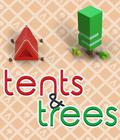The nonogram-style puzzle games get an ample amount of representation on the Nintendo Switch. Jupiter's Picross S series is the king of these, with nine mainline games on the system — along with a few other themed ones. Depiction throws the idea of colors into the mix, while Murder by Numbers places all of this in the context of a murder mystery game. They all task players with creating pictures from a grid, but all are solid enough that only nitpicking will ever cause you to rate one higher or lower than the other. Tents and Trees is the latest game to go after nonograms, but it has a twist that will make even veterans take notice.
The basic nonogram rules are in play. Presented with a perfectly square grid, players are given numbers on both the vertical and horizontal axes, which indicate how many tents need to be placed there. Using those as your hints, your goal is to place those tents in the correct configuration to solve the puzzle and move on to the next one.
From here, Tents and Trees twists the rules of nonograms a bit. For one, the completed puzzle isn't meant to represent a picture or even part of a picture, so you can't use that as another guide for the solution. Trees are also on the field, which both act as blockers that can't be moved in the grid and hints for where tents should go. The tents follow another rule in that they need to be placed near a tree in any of the four cardinal directions (up, left, down, right). Tents are symbolically linked to just one tree and cannot be placed directly next to another tent, whether in those cardinal directions or diagonally. Patches of grass can be placed anywhere and have no bearing on puzzle completion, but they can serve as markers for where a tent doesn't need to be placed.
It's difficult to grasp how different that makes things at first, but a round or two will make it clear how the game ultimately plays out. The good news is that it has the same magic that just about every other nonogram title has, where you feel smart for solving one while also anxious enough to jump into the next one almost immediately. There's a good sense of progression, where puzzles get more difficult as the grid increases in size. The immutable layout of trees can be both freeing yet restrictive, as you only have a few squares to parse out where tents will go. The game also has a batch of puzzles where the numerical hints for some rows and columns are hidden away, making things trickier but just as satisfying when you solve even the easiest of these riddles.
For those seeking help, Tents and Trees features a hint system that differs from other similar titles. Instead of filling in a random row for you, the game goes in a specific order to help you fix things up. If most or all of the squares are filled up, the game highlights any areas where mistakes were made. After that, the game goes to a random row and points out where some tents need to be placed or which squares need grass, and it keeps up those hints while you perform the work manually. The game also has a pop-up that appears when you forget one of the rules, like placing two tents close to one another, and it highlights the mistake. Unlike other games, there's no penalty for making mistakes, so you are encouraged to experiment without the fear of accruing lots of time on the clock. Taking any hints acts in a similar way, with the only change being a different colored square in the overall map once you complete a puzzle using hints. It's a forgiving system, which is encouraging considering how different these rules are from a normal nonograms title.
Tents and Trees features 500 puzzles of varying degrees of difficulty, which is more than enough for even the more dedicated puzzle fans. All of the puzzles can either be played solo or with up to four players all working cooperatively, something that's pretty novel, since multiplayer isn't something you typically see in nonograms. For those seeking more puzzles after the base batch has been completed, the game also offers daily puzzles, so the game feels almost limitless in content.
You need to nitpick if you're trying to find faults with the game. Tents and Trees offers different themes for the board, so those craving rockets and launchpads instead of the default forest theme will find it, but it requires solving a significant amount of puzzles before you can change the already pleasant visual and audio aesthetics. The same can be said for level unlocks, but the counterargument is that puzzle unlocks occur in large enough batches that you may never notice what's locked away until you skip around from page to page or play each puzzle until you get stuck and find yourself with a large swath of half-completed projects.
Tents and Trees is a solid nonograms game that does a good job of handling the twists it has for the player. The board limitations make for some very interesting puzzles, while the casual nature of the game and generous hint system don't scare away those who aren't already well versed in this type of game. With a near-limitless supply of puzzles at hand, Tents and Trees is a great recommendation for anyone who is a big fan of the genre.
Score: 8.5/10
More articles about Tents And Trees











 Think strategically to place tents in the peaceful universe of Tents and Trees, a puzzle game set in the great outdoors!
Think strategically to place tents in the peaceful universe of Tents and Trees, a puzzle game set in the great outdoors!



























